Blockchain Weekly | Policy breeze blows frequently, expecting a breakthrough in the regulatory sandbox in Hainan
Chen Yang, director of the Hainan Financial Bureau: A blockchain supervision sandbox model will be introduced in Hainan; the U.S. Treasury Secretary suggested in August that the blockchain supervision sandbox be launched. According to the Associated Press, at the high-end forum on the construction of the Hainan International Offshore Innovation and Demonstration Demonstration Zone on the morning of December 1, Chen Yang, director of the local financial supervision bureau of Hainan Province, said that the introduction of Hainan will be promoted through models such as digital encryption and blockchain. Regulatory sandbox model. Coincidentally, recently, according to the China Financial Information Network, U.S. Secretary of the Treasury Steve Mnuchin suggested in a report to U.S. President Trump this August that measures be taken to support financial technology and financial innovation, including Regulatory sandbox.
According to Finance Magnates reported on November 29, Germany is preparing legislation to allow the banking industry to sell digital assets, including Bitcoin, as a custodian. German news outlet Handelsblatt reported on this legislative plan as part of the fourth edition of the EU Anti-Money Laundering Guidelines Act. If the legislation is successful, specific measures will be implemented in 2020, and financial institutions will be able to provide their customers with services including trading of traditional securities such as stocks and bonds, as well as cryptocurrencies. According to a Reuters report on the 27th, HSBC revealed that it plans to transfer US $ 20 billion worth of assets to the blockchain-based custody platform Digital Vault by March next year. Digital Vault will allow investors to view real-time records of securities purchases in private markets. The platform will digitize paper-based private placement records and use blockchain to save investors the time to view and query positions.
The domestic regulatory overweight has recently cleared up and standardized the chaos in the industry, and the positive supervision is also accelerating to follow up. As an international offshore innovation and entrepreneurship demonstration area, Hainan is very suitable for blockchains, which are naturally a financial hotspot, as a hotbed of innovation. In the spring breeze of policy, we expect the blockchain to produce good fruits in Hainan!
- Technical Tutorials | ENS: Add Multicurrency Support to Your Wallet
- Does the tea industry also need blockchain technology? Indian Tea Board says it is needed!
- The strongest opponent that DCEP may face in the future may not be Libra, but …
Last week's market review: Chainext CSI 100 rose 7%, and the IoT & traceability performance in the segment was the best. From the perspective of subdivisions, the performance of IoT & traceability, entertainment and social networking, storage & computing is better than the average of Chainext CSI 100, + 30.14%, 11.07%, 8.99%, respectively. Payment transactions, commercial finance, foundation enhancement, foundation chain, The performance of pure currency blocks was inferior to the average level of Chainext CSI 100, + 2.64%, 5.62%, 2.43%, 6.46%, 6.27%, and 3.01%, respectively.
Risk Warning: Uncertainty of regulatory policies, project technology progress and application landing is less than expected, and cryptocurrency-related risk events occur.

1. Hotspot tracking: Under the spring breeze of policy, I expect the blockchain to have good results in Hainan
Chen Yang, Director of Hainan Financial Bureau: A blockchain supervision sandbox model will be introduced in Hainan. The U.S. Treasury Secretary suggested in August the launch of a blockchain regulatory sandbox. According to the Associated Press, at the high-end forum on the construction of the Hainan International Offshore Innovation and Demonstration Demonstration Zone on the morning of December 1, Chen Yang, director of the local financial supervision bureau of Hainan Province, said that Hainan will learn from international financial experience, establish a fault tolerance mechanism, and work hard to create A relaxed and orderly environment, resolutely defending the bottom line of financial risks, fully handling the relationship between development and security, and allowing fintech to better serve the real economy. At the same time, we will further delineate the regulatory bottom line, strengthen the use of financial regulatory technology, and promote the introduction of a regulatory sandbox model in Hainan through digital encryption and blockchain models.
The concept of regulatory sandbox was introduced by the British government in 2015. As defined by the Financial Conduct Authority (FCA) in the UK, a “regulatory sandbox” is a “safe space” in which fintech companies can test their innovative financial products, services, business models and marketing methods, and There is no need to be immediately bound by regulatory rules when problems arise in related activities.
The first batch of resident companies such as Oke Group signed a strategic cooperation agreement with Sanya City. Oke Group announced that it will set up a blockchain offshore digital asset trading laboratory in Sanya, and subsequently build a blockchain big data research institute and blockchain innovation. Application R & D Center and other sections. This is another heavyweight provincial blockchain supervision sandbox model following the establishment of the China Blockchain Supervision Sandbox in Hangzhou Bay Industrial Park and Hangzhou Grand Bay Area Blockchain Industrial Park in September 2018.
Coincidentally, recently, according to the China Financial Information Network, U.S. Secretary of the Treasury Steve Mnuchin suggested in a report to U.S. President Trump this August that measures be taken to support fintech and financial innovation, including the implementation of Regulatory sandbox. This report analyzes the current monetary system and proposes a thorough reform of cryptocurrencies to foster new technologies in a weakened regulatory environment. The U.S. Treasury acknowledges the rise and rapid development of cryptocurrencies and blockchain technology, and states that blockchain and distributed ledger technologies are currently under the direct management of the U.S. Financial Stability Oversight Board. The U.S. government supports this technology and has stated that it will promote Regulations on the growth of emerging industries are critical to the overall regulatory system.
According to Finance Magnates reported on November 29, Germany is preparing legislation to allow the banking industry to sell digital assets, including Bitcoin, as a custodian . German news outlet Handelsblatt reported on this legislative plan as part of the fourth edition of the EU Anti-Money Laundering Guidelines Act. If the legislation is successful, specific measures will be implemented in 2020, and financial institutions will be able to provide their customers with services including trading of traditional securities such as stocks and bonds, as well as cryptocurrencies. It is reported that the legislation will further relax the application deadline for required licenses. The bill is said to have been passed by the German Bundestag and is currently awaiting consensus in the country's 16 states.
Currently, German banks and financial institutions prohibit the sale of digital assets to their customers. However, the new bill could push Germany into the next center of the cryptocurrency industry. According to a Reuters report on the 27th, HSBC revealed that it plans to transfer US $ 20 billion worth of assets to the blockchain-based custody platform Digital Vault by March next year. Digital Vault will allow investors to view real-time records of securities purchases in private markets. The platform will digitize paper-based private placement records and use blockchain to save investors the time to view and query positions. Reuters also reported that Norwegian, Danish and Kenyan Red Cross organizations launched a two-year project on the 26th, using blockchain-supported “local currencies” to help solve Kenya ’s lack of hard currency and make Kenya ’s poor communities smooth. Carry out trade and stimulate economic activities. These projects are designed to improve the use of $ 1 billion in cash and tokens a year by the Red Cross to meet pre- and post-disaster needs. The new currency uses points that can be transferred by mobile phones and is automatically recorded on the blockchain. Residents in slum areas can earn points through labor and use those points to purchase local food and services.
At the stage when the national regulatory rules are not mature, blockchain practitioners also face many legal risks . According to The Block, on November 29, the U.S. Attorney's Office and the FBI in the Southern District of New York announced that they had arrested and charged Virgil Griffith, an Ethereum research scientist, with violating U.S. sanctions laws for providing North Korea with the use of cryptocurrencies and blockchain Presentations and recommendations for techniques to evade sanctions. US lawyer Geoffrey S. Berman said in a statement that Virgil Griffith was accused of providing North Korea with highly technical information that he knew could be used to help North Korea launder money and evade sanctions. Endangers sanctions already promulgated by Congress and the President. Griffith has been charged with conspiracy to violate the International Emergency Economic Powers Act, which is punishable by up to 20 years in prison.
The domestic regulatory overweight has recently cleared up and standardized the chaos in the industry, and the positive supervision is also accelerating to follow up. As an international offshore innovation and entrepreneurship demonstration area, Hainan is very suitable for blockchains, which are naturally a financial hotspot, as a hotbed of innovation. In the spring breeze of policy, we expect the blockchain to produce good fruits in Hainan!
2. News from governments: The French central bank: Call on the euro area to establish a blockchain-based settlement system
The amendment to South Korea's special financial law on virtual assets has been approved by the Administrative Committee, and needs to be passed by the Judiciary Committee and the Plenary of Congress. The Korean Financial Services Commission (FSC) stated that the Korean Parliament ’s Administrative Committee yesterday approved the amendments to the “Reporting and Utilization of Information on Certain Financial Transactions (Special Financial Law)” amendment (which may be subject to partial changes based on the Judicial Committee) This means that South Korean virtual assets have taken an important step in the process of institutionalization.

3. Industry chain-related developments: BTC miners' earnings fell 14.3% MoM
Last week, BTC added 2.09 million transactions, a decrease of 3.3% from the previous month; ETH added 4.61 million transactions, a decrease of 6.8% from the previous month.
Last week, the average daily income of BTC miners was 12.72 million US dollars, down 9.7% from the previous month; the average daily income of ETH miners was 1.89 million US dollars, down 12.1% from the previous month.
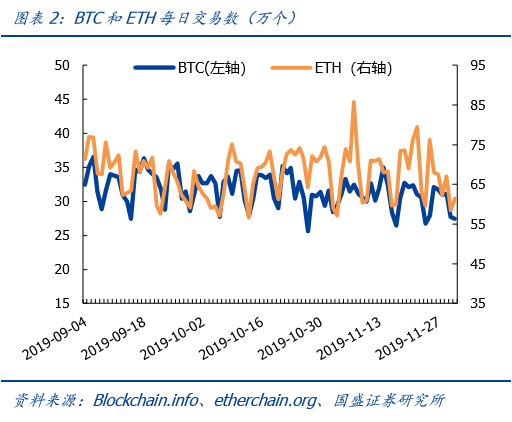
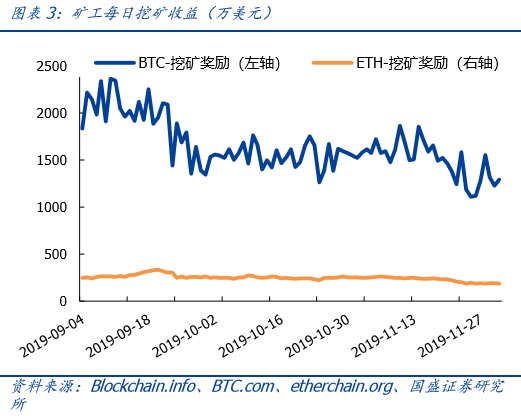
Last week, the average daily hashrate of BTC reached 87.5EH / s, a decrease of 4.4% from the previous month; the daily average hashrate of ETH across the network reached 174.9TH / s, a decrease of 2.6% from the previous quarter.
Last week's BTC network-wide mining difficulty was 12.97T, an increase of 1% from the previous month. The next difficulty adjustment date is December 6, with an estimated difficulty value of 12.59 T (-2.97%). Last week, the average ETH network-wide mining difficulty was 2.52T, an increase of 3.3% from the previous quarter.
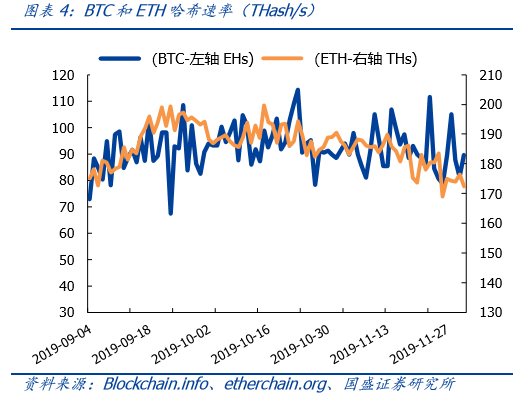
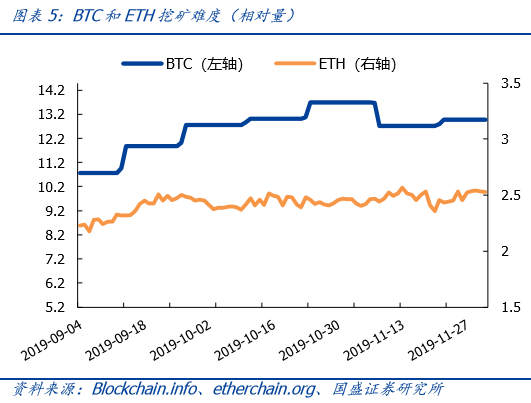
4. Last week's market review: Chainext CSI 100 rose 7%, and the IoT & traceability performance in the segment was the best

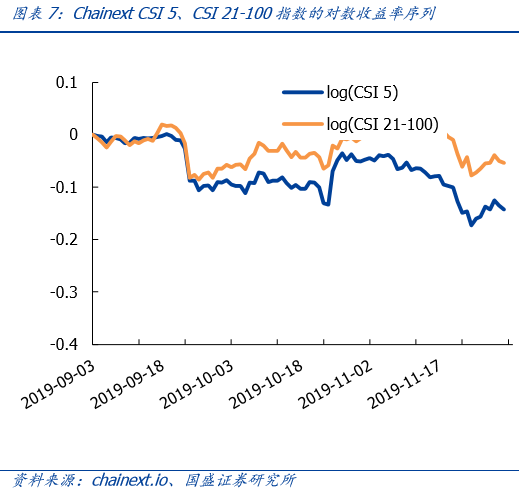
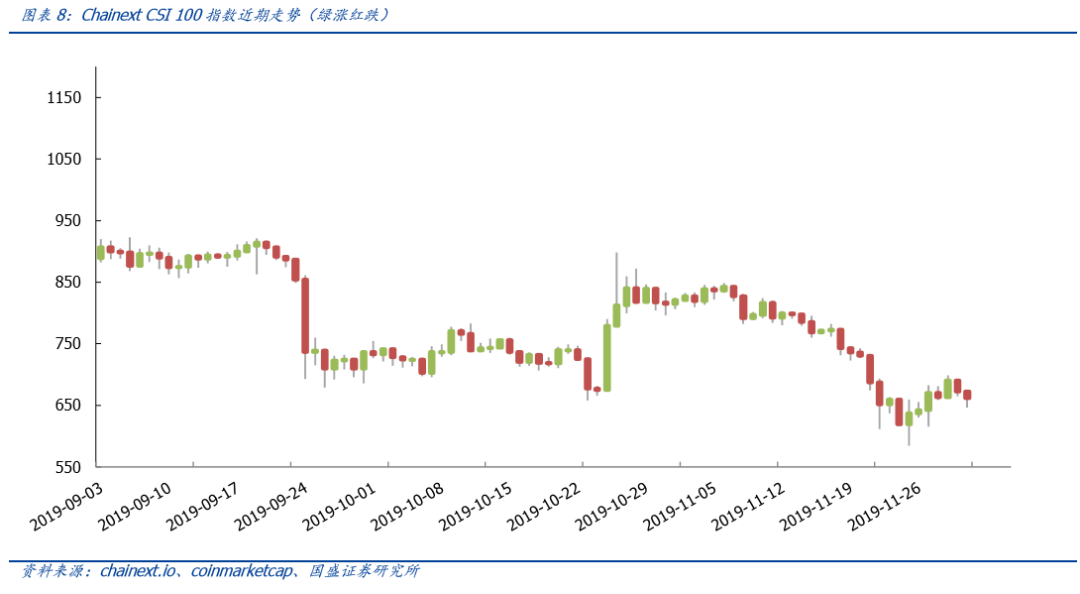
From the perspective of subdivisions, the performance of IoT & traceability, entertainment and social networking, storage & computing is better than the average of Chainext CSI 100, + 30.14%, 11.07%, 8.99%, respectively. Payment transactions, commercial finance, foundation enhancement, foundation chain, The performance of pure currency blocks was inferior to the average level of Chainext CSI 100, + 2.64%, 5.62%, 2.43%, 6.46%, 6.27%, and 3.01%, respectively.
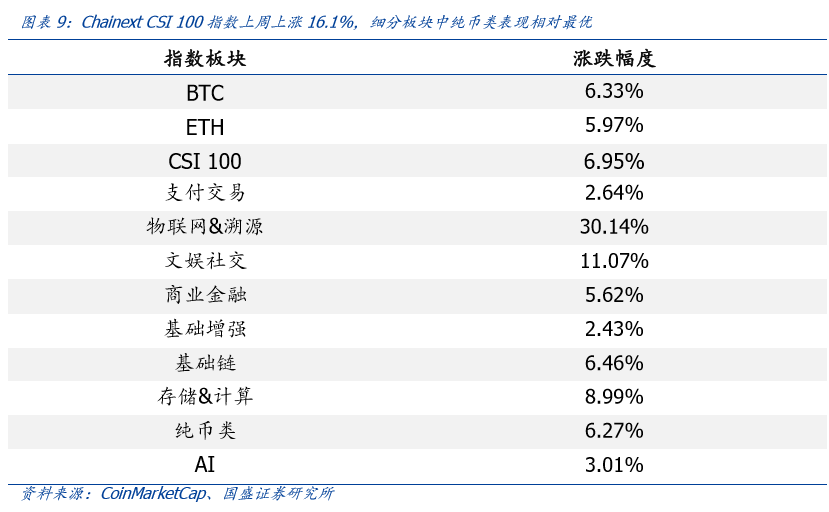


2. The technical progress and application of the project fell short of expectations;
3. Risk events related to cryptocurrencies occur.
We will continue to update Blocking; if you have any questions or suggestions, please contact us!
Was this article helpful?
93 out of 132 found this helpful
Related articles
- The EOS node's renewed conflict centralizes the characteristics of the public chain, highlighting the responsibility of Block.one?
- Need Bitcoin to transform? Here are three main reasons
- Want to do a good job of blockchain data analysis? First look at how to solve the big problem of "deanonymization"
- What happened to the netizen who "lost" 4 bitcoins on the Lightning Network?
- U.S. lawmakers seek to classify stable currencies like Libra as securities
- Introduction to Blockchain | Advanced Understanding of Smart Contracts-Implementation
- Interview 丨 Chain Node CEO Qu Zhaoxiang: To make the blockchain popular, it should be made a trend symbol






